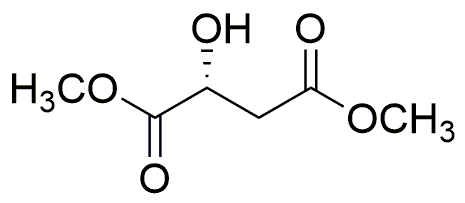Dimethyl (R)-(+)-malate is widely utilized in research focused on:
- Flavor and Fragrance Industry: This compound is used as a flavoring agent in food products, providing a fruity taste that enhances the overall sensory experience.
- Pharmaceutical Applications: It serves as an intermediate in the synthesis of various pharmaceuticals, contributing to the development of new medications with improved efficacy.
- Biochemical Research: Researchers employ it in metabolic studies to understand its role in energy production and its effects on cellular processes.
- Cosmetic Formulations: The compound is incorporated into skincare products for its moisturizing properties, helping to improve skin texture and hydration.
- Biodegradable Plastics: It is explored as a building block for creating eco-friendly polymers, promoting sustainability in the materials industry.
General Information
Properties
Safety and Regulations
Applications
Dimethyl (R)-(+)-malate is widely utilized in research focused on:
- Flavor and Fragrance Industry: This compound is used as a flavoring agent in food products, providing a fruity taste that enhances the overall sensory experience.
- Pharmaceutical Applications: It serves as an intermediate in the synthesis of various pharmaceuticals, contributing to the development of new medications with improved efficacy.
- Biochemical Research: Researchers employ it in metabolic studies to understand its role in energy production and its effects on cellular processes.
- Cosmetic Formulations: The compound is incorporated into skincare products for its moisturizing properties, helping to improve skin texture and hydration.
- Biodegradable Plastics: It is explored as a building block for creating eco-friendly polymers, promoting sustainability in the materials industry.
Documents
Safety Data Sheets (SDS)
The SDS provides comprehensive safety information on handling, storage, and disposal of the product.
Product Specification (PS)
The PS provides a comprehensive breakdown of the product’s properties, including chemical composition, physical state, purity, and storage requirements. It also details acceptable quality ranges and the product's intended applications.
Certificates of Analysis (COA)
Search for Certificates of Analysis (COA) by entering the products Lot Number. Lot and Batch Numbers can be found on a product’s label following the words ‘Lot’ or ‘Batch’.
*Catalog Number
*Lot Number
Certificates Of Origin (COO)
This COO confirms the country where the product was manufactured, and also details the materials and components used in it and whether it is derived from natural, synthetic, or other specific sources. This certificate may be required for customs, trade, and regulatory compliance.
*Catalog Number
*Lot Number
Safety Data Sheets (SDS)
The SDS provides comprehensive safety information on handling, storage, and disposal of the product.
DownloadProduct Specification (PS)
The PS provides a comprehensive breakdown of the product’s properties, including chemical composition, physical state, purity, and storage requirements. It also details acceptable quality ranges and the product's intended applications.
DownloadCertificates of Analysis (COA)
Search for Certificates of Analysis (COA) by entering the products Lot Number. Lot and Batch Numbers can be found on a product’s label following the words ‘Lot’ or ‘Batch’.
*Catalog Number
*Lot Number
Certificates Of Origin (COO)
This COO confirms the country where the product was manufactured, and also details the materials and components used in it and whether it is derived from natural, synthetic, or other specific sources. This certificate may be required for customs, trade, and regulatory compliance.

